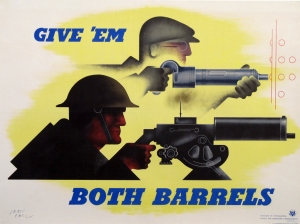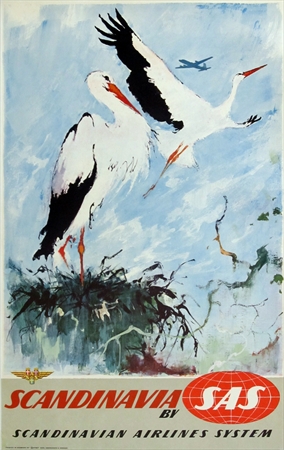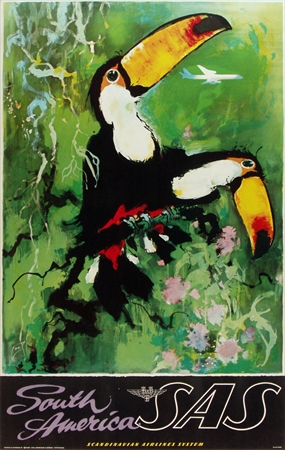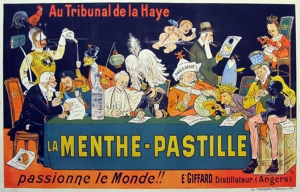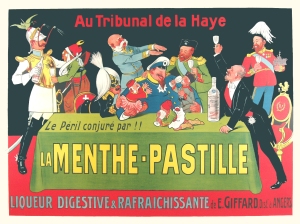Air France: French West Africa and Extrême Orient
August 14, 2016 § Leave a comment
After World War Two commercial air travel was, for the first time accessible to the public. Wartime technological advancements including radar and improvements in engineering led to faster, safer, and larger planes. An adventurous traveler could now leave their continent and in less than a day find themselves on the other side of the globe. Travel posters, always a tool of mass communication, showed exotic destinations as a means of announcing, “The world is now open to all.” Air France, one of the preeminent airlines both before and after WWII, employed the poster expertly. Their routes traced a history of commerce and many were carved out through colonialism. It is interesting to look at Air France’s choices of which destinations to promote to tourists in their advertising posters and also to examine the images used to evoke adventure, exoticism and ownership.
Although the war afforded advancements in technology and global economics, other institutions, like colonialism, persisted. Many European countries held stake in colonies thousands of miles apart. The British Empire’s holdings in India, the Middle East, and East Africa are often at the forefront of people’s minds, however, France and even smaller nations like Belgium and Portugal were key colonial players. France held power in North and West Africa as well as Vietnam, Laos, Cambodia, and the Caribbean.
***
Of the Allied powers, the French suffered particular hardship during WWII. As a Nazi occupied nation and one situated on the front lines, France’s infrastructure and economy were decimated by the end of war. Despite this, companies like Air France thrived in the new postwar environment. Flights around France, Europe, and the French colonies in Africa, Asia, and the Caribbean became increasingly popular. France’s colonial presences in West Africa and the Far East or L’Extrême Orient, especially Vietnam, made travel to these locations seem exotic yet possible. Posters, like the ones below, were created to market these destinations. The posters themselves, very similar in subject matter, speak to the ethos of the time.
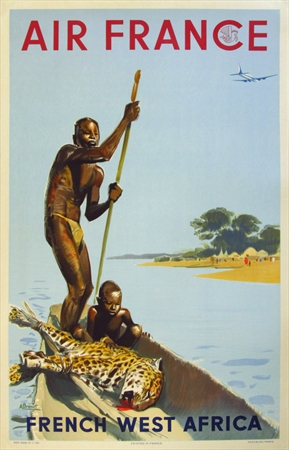
The West Africa poster was created in 1949 by Albert Brenet and shows two young men in a West African pirogue with their prey. This striking image makes references to the exotic bounty of the colony and would have grabbed the attention of any passer by.
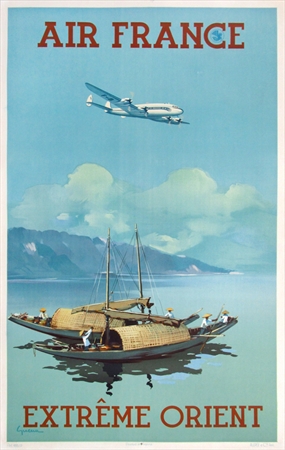
Extrême Orient by Vincent Guerra, was printed in in 1950 and features a beautiful bay and mountain scene with fishermen in their woven topped junks. The prominence of the plane shows France’s ownership of this scene as if to say “It’s ours- come explore it.” Both of these images seem to symbolize a rural, bucolic lifestyle that wasn’t quite the reality (pg. 130 Air France, https://www.scribd.com/document/54130846/The-Junk-Blue-Book). The Vietnam of the 1950s was fully embroiled in a war for its independence, first from the Japanese, then the French, culminating in the Vietnam War.
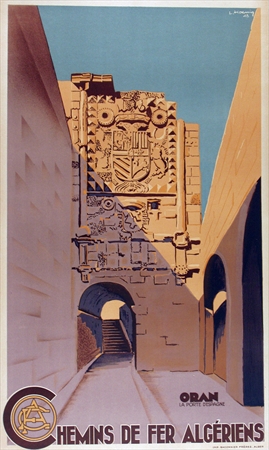
West Africa suffered similar hardships at the hand of its colonial rulers. While embroiled in bureaucratic struggles for recognition by the French Government, the native peoples of these West African nations, (Sénégal, Mali, Côte D’Ivoire, Burkina Faso, Mauritania, French Guinea, Benin, and Niger) were treated as subjects not citizens. Independence came in March of 1962 after the bloody Algerian War.
Today the colonial references on these posters are so obvious as to be almost embarrassing to the Western viewer. But they are an indelible record of the prevailing attitudes of the time period, as are all advertising posters. It’s important that they be preserved so that their messages are not forgotten.
This post was written by Susannah Starr, Summer Intern and Elizabeth Norris, Proprietor of Vintage European Posters.
Established 1997
Member IVPDA
Our Shop: 2201 Fourth Street, Berkeley Corner of Allston Way
Summer Hours Tuesday- Thursday 11-5
and select weekends
Also available by appointment
Please call 510 843 2201 or email vintageposters@vepca.com to confirm hours.
Visit our collection on the web at vepca.com
Cycles Lea
July 26, 2016 § Leave a comment
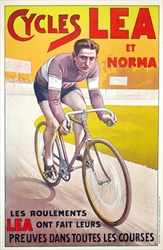
Anonymous, Printed in Belgium, circa 1910 Original Stone Lithograph
The bicycle was invented in the 1860’s and so was still a ‘new technology’ at the time this poster was made. European roads were used by horses and carriages and weren’t ideal for cycling, so velodromes and tracks were favored by early enthusiasts. This piece shows a track cyclist, intent on his goal of winning the race. The advertisement is for the bicycle and brags about the ball bearings which are ‘proven’ on the best courses. The artist does a tremendous job with detail and in particular captures the details of the bicycle all the way down to the toe clips.
This post was written by Elizabeth Norris, owner of Vintage European Posters
Vintage European Posters is a Berkeley based dealer of
Original French & American Advertising Posters.
Our Showroom is located at 2201 Fourth Street in Berkeley, corner of Allston Way.
Summer of 2016 we are open on Tuesdays, Wednesdays and Thursdays 11-5
and select weekends. Please call ahead to confirm our hours.
Established in 1997, VEP now exhibits at 12 shows per year in California including
Dwell on Design, Palm Springs Modernism, and the Healdsburg Antiques on the Plaza.
Our website www.vepca.com is always up to date.
Designed to Make You Want to Work for Your Country
March 13, 2014 § Leave a comment
This post was written by Elizabeth Norris, owner of Vintage European Posters.
You can visit our showroom at 2201 Fourth Street in Berkeley on Tuesdays – Thursdays
Call us at 510 843 2201 to schedule an appointment.
Our next pop up open weekend is April 5-6, 2013. You can see our collection at www.vepca.com
You can also see us in Los Angeles at LA Modernism April 25-27
Otto Nielsen’s Fabulous SAS Posters
August 16, 2013 § Leave a comment
It’s summer, which makes many of us dream of travel. In the 1960’s Otto Nielsen promoted the romance and excitement of faraway lands with his series of posters for the Danish airline SAS. Nielsen was a watercolor painter who when tasked with this graphic challenge, came up with the clever idea of depicting animals traveling two by two to exotic destinations.
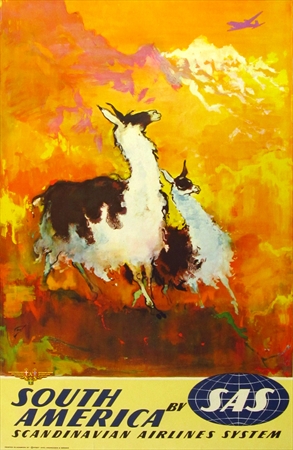
Original poster for South America SAS printed circa 1960
In the early SAS posters, you sometimes see the cool oval globe in dense color. The type style is tight, and in some ways suggests the early Pan Am lettering. The type style changes dramatically in a very short period of time. In the mid 60’s, Nielsen employs a looser brush stroke lettering and embraces daring color. The evolution of Otto Nielsen’s style is apparent when looking at a group of his posters side by side. We are pleased to be able to do just that here at VEP as we have just acquired six more SAS posters, bringing our total collection up to 13.
Our new acquisitions are not yet available on our website. To see them, and all of our new acquisitions, visit us at the 15th Annual Preview Show, August 16th-18th at Grace Street Catering- 4629 Martin Luther King Jr. Way in Oakland.
Friday 12-8 (Happy Hour 5-8)
Saturday 11-6
Sunday 12-5
Watch for a new blog post next week for more SAS posters.
Eugene Oge and La Menthe Pastille
August 24, 2012 § 2 Comments
The greatest thing about collecting original posters is how much we get to learn about 19th and 20th century history just by soaking up these colorful collectibles. I recently found a Menthe Pastille poster by Eugene Oge which struck me as just such an opportunity to learn more about the period leading up to World War I. It is uncommon for a poster artisit to uses political humour in an advertising poster—politics can be too controversial, and might alienate the consumer from a brand, but in this example, Oge does a great job creating caricatures of the world’s leaders.
The poster from 1904 shows a total of 13 figures, each representing something different and interacting together to show political situations in Europe. They sit at a table with a tablecloth decorated with the large text of “La Menthe-Pastille.” All the figures look as if they are in peaceful talks with each other. On the left, Oge depicts William II serving a drink to the Japanese Emperor, Matsuhito. In the foreground, the Emperor of France is being comforted about his inability to produce a male heir. The Japanese Emperor stands behind the Emperor of France, even though they are enemies, but the Emperor of France does not seem concerned. In the middle of the table, the newly chosen Catholic Pope puts his arm around King Emmanuel III of Rome. Next to King Emmanuel III on the right is Edward VII, King of the United Kingdom, who smokes and gazes at the globe that the man on his right, Jacques Lebaudy, gazes at as well. Behind those two figures is Leopold II of Belguim at an image of his “muse” Cleo de Merode. Next, to the right, is Alfonso XIII who sits regally, wearing his crown, as he recently was coronated King of Spain. Lastly, below him sits Uncle Sam with a small African American baby on his lap.
In the 1913 poster, the figures are fewer, and some major players in the European situation are either out of power or not longer alive. Only 10 people now populate the poster. **Those missing are Emile Loubet, the French Emperor, and two people who had since died: Edward VII and Leopold II. The situation is much more tense here, and inflammatory situations are shown here that La Menthe-Pastille, William II tries to become allies with the Ottoman Sultan Mehmet V. In the center of the poster, the Kaiser Frederic William, plays with three small childlike figures who represent the Kings of Serbia, Bulgaria, and Greece. This poster again tells people to drink La Menthe Pastille to inject tranquility and ease into their lives, but in 1913, the statement is more adamant.
Sources
* Eugene Oge: Affichiste , Anne-Claude Lelieur et Raymond Bachollet, published 1998 by Agence Culturelle de Paris. p. 214-215)
** Eugene Oge: Affichiste , Anne-Claude Lelieur et Raymond Bachollet, published 1998 by Agence Culturelle de Paris.pages 224-225)
This post was written by Karlie Drutz, San Francisco State Museum Studies Student and VEP intern and Elizabeth Norris, Owner, Vintage European Posters.
See our entire collection of original vintage posters from Europe and the United States at www.vepca.com or visit us on Tuesdays or by appointment at our Berkeley Showroom 2201 Fourth Street in Berkeley, CA

